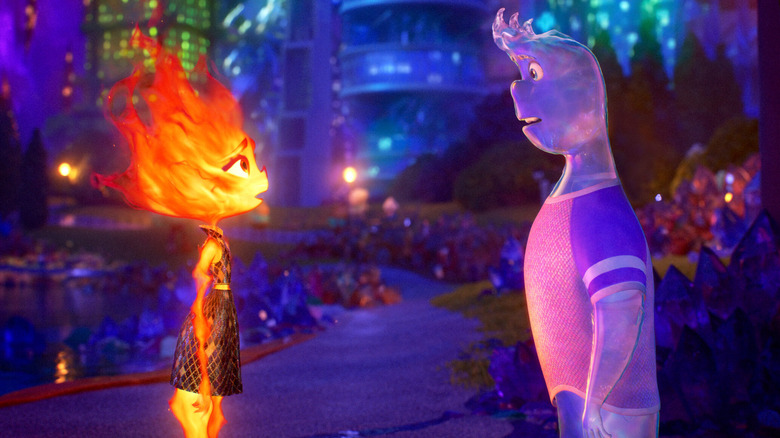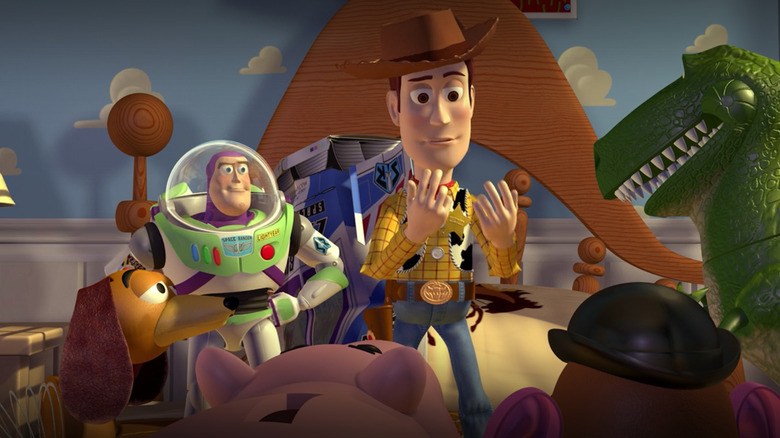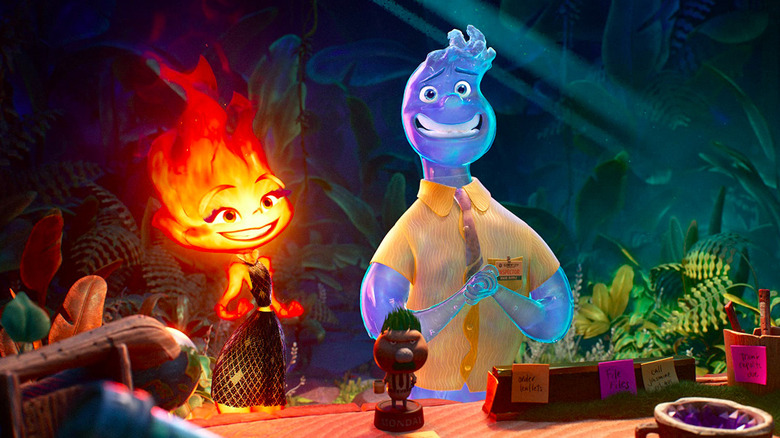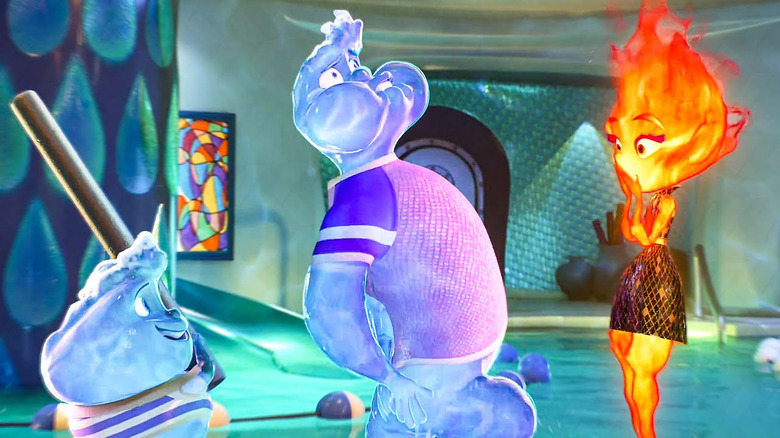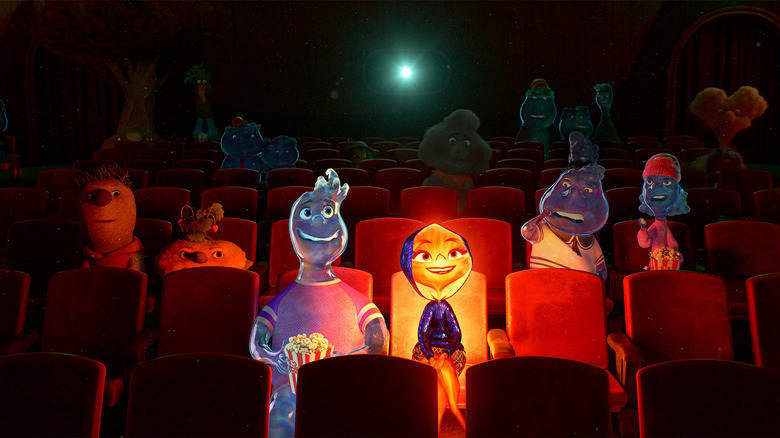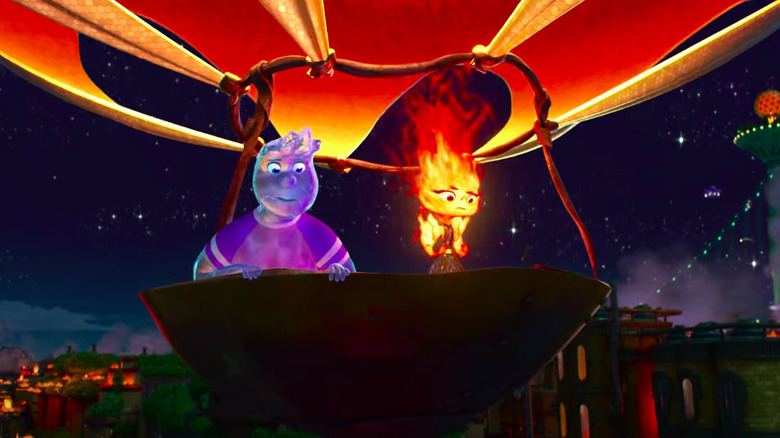Elemental Required The Most Computer Power Pixar Has Ever Used For A Movie
This week brings Pixar back to theaters again with the release of "Elemental." The new animated movie unfolds in a place called Element City, which has evolved around characters made of water, fire, land, and air. The inhabitants live together as best they can, though fire people still feel a bit like outcasts due to their naturally destructive elemental existence. But that doesn't stop a spark from flying between a go-with-the-flow water guy named Wade and a fiery young woman called Ember.
However, for an entirely different reason beyond elemental opposition, bringing together characters made of water and fire was supremely challenging for Pixar Animation. In fact, Wade and Ember being made of water and fire required Pixar to change their workflow throughout production. But perhaps the most interesting revelation from "Elemental" filmmakers was that the film required more computer power than Pixar had ever used for a movie before.
As production designer Don Shank explained during an "Elemental" press event that /Film attended back in March, having characters made of fire and water forced them to go back and forth constantly between what they wanted artistically and what was technically possible in animation, which may explain why it took seven years to come together. Shank said:
"At the beginning, it was a bit of a chicken and egg type situation. What did we want to do artistically and what could we do technically? Our technical abilities informed and inspired design choices, and then those design choices in turn inspired new technology, which then inspired new designs. So there was a lot of back and forth between our art and our technical teams as we discovered together how to make appealing elemental characters that still felt like they had the visceral impact of real fire, water, air, and earth."
'All of our films have technical challenges, but we haven't had one on the scale of 'Elemental' in a while'
Because "Elemental" required new technology in order to properly execute the existence of Wade and Ember, visual effects supervisor Sanjay Bakshi was "terrified" when faced with the kind of artistic and technical leaps required to make the movie work. But he was encouraged by Pixar's long history of innovation. Bakshi recalled:
"When Pixar made 'Toy Story' in 1995, they had never made a feature length animated movie before. In fact, no one had. They had to figure it out. Pixar had only made a few short films and each of those were about less than five minutes in length. The storyboards from 'Monsters Inc.' featured this character Sully, this furry character, and picture Pixar had never made a fully simulated furry character before. Similarly, when we saw the boards for ['Finding] Nemo,' we didn't know how to do all that water. Water is a hard problem in CG, and it's still really hard. All of our films have technical challenges, but we haven't had one on the scale of 'Elemental' in a while."
In fact, "Elemental" required more computing power than Pixar had ever used before, even when they set "Finding Nemo" entirely underwater. Bakshi said Pixar had to upgrade computers and buy new ones in order to complete the movie. Within these machines, they have a number of cores, which are like the brains of the computer. When "Toy Story" was made, they only needed 294 cores and the Sun Microsystem computers that housed them aren't even made anymore. "Monsters. Inc" and the hairiness of Sully required 672 cores. The underwater adventure of "Finding Nemo" needed 923 cores. For "Elemental," Pixar utilized over 150,000 cores to complete the movie.
'Ember and Wade are unlike anyone we've ever animated before'
What is it about "Elemental" that required so much computing power? As directing animator Gwendolyn Enderoglu explained to us:
"Ember and Wade are unlike anyone we've ever animated before. They're composed of organic matter with no structure, so that offers an animator so much freedom and flexibility, but we still also had to capture the subtle thoughtful performances of these two. So our team's challenge came down to this: We wanted to honor the truth to materials while also still delivering beautiful and compelling performances. The animation style we were chasing had to artfully bridge these two concepts and strike the right balance."
As water and fire, Wade and Ember are constantly in motion, even more than your average character. Wade's body and face have ripples and bubbles, Ember's body and face wave around like a flame and can even extinguish slightly with fast movement. That requires a lot of processing power to render when all is said and done. For example, Enderoglu explained, "A typical Pixar rig has about 4,000 controls," but in the case of "Elemental," the characters of Wade and Ember "had roughly 10,000 individual animation controls each."
Adding to that challenge was a change in the typical workflow for Pixar Animation, especially in the effects department.
'These are dynamic simulated characters, so we needed to work closely and collaboratively with animation and characters'
Effects supervisor Stephen Marshall was responsible for developing and delivering the effects for all fire, water, and air characters on the movie. Typically, the effects department is working on the movie after characters have been developed and animation is complete. As Marshall described it, "Usually effects is bread and butter. It's destruction, explosions, floods, et cetera. And we generally don't have a lot of communication with the characters department as they tend to be done before we begin." But that all changed with "Elemental."
Since Wade and Ember are made of water and fire (along with dozens of other characters who appear in the movie), they require a lot of effects work, and that had to be completed in harmony with character creation and animation, mostly because the effects, in this case, were used to enhance character performance. Marshall said:
"These are dynamic simulated characters, so we needed to work closely and collaboratively with animation and characters. This would shoot during early development as well as during shot work. A notable change in this new pipeline is that we work together with character shading throughout the show. Based on demands of 'Elemental,' there were three main challenges we needed to solve. Stability and predictability. Ember needs to always look like Ember with minimal tweaking per shot. We wanted to provide animation controls. Pixar animators are incredibly talented, so we needed to leverage their skills as much as possible. And we took a layered approach to detail. Fire can be extremely busy, so we needed to have control over all aspects of the final image."
'Our characters are also both stylized and physically based'
Even the smallest details required additional effort because of the properties of fire and water that were always present in Ember and Wade. Junyi Ling, a character co-supervisor on the movie, dug into the challenges of both fire and water characters. When it comes to fire, Ling broke it down:
"For fire characters, we have some major challenges. Using a previous analogy, character shading is like painting on the surface of a puppet, right? But fire, there is no surface. So it's a much harder problem, because we have to paint an almost infinite number of layers of volumetric layers and because you can see all the way through the fire. Because fire is highly complex, it is very dynamic, it's constantly moving, and it's self illuminating, meaning that our characters are actually light sources. Our characters are also both stylized and physically based. You have two competing kind of things that we have to match. And also we have dynamic emotions..."
Fire may have been challenging, but as director Pete Sohn and producer Denise Ream confirmed, it was the water characters who gave them the most trouble. Though Pixar had animated water plenty of times before, it didn't make this process any easier for them. As Ling explained, "Physically based water is very refractive and reflective ... It is amorphous, it is dynamic, it is mesmerizing, but it will be very hard to create a face from this as you can imagine."
In an early example, Ling pointed out how the natural reflection and refraction of water made it possible to see the back of Wade's teeth and eyeballs, making for a rather terrifying character. So they had to figure out how to bring the physics of water to Wade while also bending them in order to make Wade appealing visually.
Dazzling animation and innovation
These are just some of the tidbits that made "Elemental" a crowning technical achievement in Pixar's relatively short history in animation. Their computer power is growing right along with their innovation in animation, and all things considered, they've evolved dramatically in quite a short period of time. Granted, there have been times when the technical aspects of Pixar have been more impressive than the movie itself, but the animation studio isn't always going to be perfect, even if that's what a lot of audiences have come to expect over the years. While there might be missteps in Pixar's movies over the years, you can't deny that their approach to animated storytelling is unparalleled, and they never let any perceived technical limitations hold them back from telling the stories they're passionate about. "Elemental" and its dazzling animation is a perfect example of that, and it's playing in theaters starting today.
